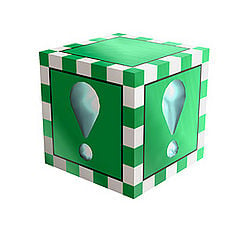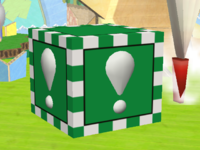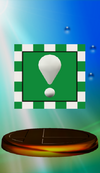Metal Box
| Metal Box | |
|---|---|
 Metal Box artwork from Brawl. | |
| Universe | Mario |
| Appears in | SSBM SSBB SSB4 |
| Item class | Transforming |
| Article on Super Mario Wiki | Metal Box |
The Metal Box (緑ブロック, Green Block) is an item from the Mario series that appears in Super Smash Bros. Melee, Super Smash Bros. Brawl, and Super Smash Bros. 4. The Metal Box encases a character's body with metal for a short period of time, which has various effects on the character. It does not affect Pikmin. Images of each character's metal form can be found here.
Description
The Metal Box encases the character's body in metal. In all four games, it has the following effects:
- It lasts about twelve seconds, but the time limit decreases as the user takes damage, especially from fire attacks like Bowser's Fire Breath. Powerful multi-hit attacks, such as Peach's down smash in Melee, however, can instantaneously cause the effect to wear off.
- User becomes heavier (about 3 times more), thus received knockback will be reduced.
- Slightly increases jumping height.
- Doubles a character's falling speed, making recoveries harder, and more vulnerable to certain chain grabs. Certain characters with multiple double jumps will not gain any net vertical distance while under the effects of a Metal Box, as they will fall below where they had began the jump before being able to jump again.
- Reduces walking and dashing speed slightly.
- Attacks performed by a metal character deal slightly more knockback, although the damage dealt remains unchanged.
- Metal characters receive some minor knockback resistance; in both games, weak projectiles such as Link's Arrows, and most jabs, will merely deal damage with no flinching.
- Removes any character's voices (although, as sound effects are still retained, Samus and Mr. Game & Watch are unaffected by this). However, getting knocked beyond the blast line of any stage will make the character scream as usual (with the exception of Smash 4).
- There is a sound effect like metal hitting a surface upon taking a step. However, the sound more closely resembles a thin sheet of metal, suggesting that the character isn't turned into metal, just covered with it.
The effects of the Metal Box are not quite as drastic as the various Metal fights in Classic Mode; Metal characters fought in Classic Mode will remain metal the whole battle and never wear off, and will lack voices of any sort when KO'd. Additionally, their stock icon (in Melee) will have a distinctly darker 'metallic' look.
Super Smash Bros.
The Metal Box does not appear in SSB, but Metal Mario appears as a foe the player must battle in the 1-Player Game. Metal Mario here can take well over 300% damage before being sent flying off-screen.
Super Smash Bros. Melee
The Metal Box makes its debut in Melee. In this game, when characters break the Metal Box with a physical attack (be it with their hands, feet, or a weapon; so long as it isn't a projectile), their whole body will be encased with metal. The metal condition lasts around twelve seconds and then fades away. During this period they are approximately 3 times heavier than normal. If a projectile destroys the Metal Box, then no one can receive the metal condition. Interestingly, Ness' dash attack destroys the box, but does not give him the metal status. Characters can fight Metal Mario and/or Metal Luigi in Adventure Mode. In addition, they also fight a random metal character in Classic Mode. The Metal Box also appears as a collectible trophy.
Characters that are metal will also become mute (Star KO'd characters will not make any sounds, for example).
Depending on the weight of the character, distinctive sounds are made while walking. Lighter characters make a soft clanging noise, middleweights make a deeper one, and heavyweights make a far deeper and louder one.
Heavy characters such as Ganondorf, Samus, and Link and light characters such as the Ice Climbers and Zelda all make middleweight stepping sounds, despite not being medium weight.
Super Smash Bros. Brawl
The Metal Box appears again in Brawl with its effect unaltered, although it will not react to projectiles. In addition, a "Metal" option exists in Special Brawl, which gives every player a permanent Metal Box effect. It also has an effect on the new ability to swim; while characters will not sink as Metal Mario did in Super Mario 64, they will submerge deeper after falling into the water. This technique is used to reach a secret area in the Glacial Peak level of the Subspace Emissary mode (3 metal boxes are provided nearby). In Classic Mode, the player must also fight a random metal character. Additionally, the Metal Box also appears as a collectible trophy. The walking sound effect in Brawl is not the same as in Melee; everyone has the same sound when walking.
Super Smash Bros. 4
The Metal Box returns as an item. The physics are mostly the same as previous Smash games. In the 3DS version, a purely aesthetic difference is that the metal texture appears to be translucent (allowing players to see, for example, Mario's irises and pupils), rather than being opaque like in previous games. In the Wii U version, the translucency is absent, and the Metal characters appear similar to how they do in Brawl; however, the player can clearly see the stage reflected on the character's body (as opposed to just a silver shade). The Metal Box is also available as a red item in Smash Tour, giving players the ability to start a battle in metal form.
Trophies
Melee
- Metal Box
- First spotted in Super Mario 64, the Metal Box holds the power to turn your character briefly into heavy metal. Your mass is exponentially greater while metallic, making it difficult for others to throw you. Be careful, though: not only will you move a bit slower, but you'll also fall much more quickly than you ordinarily would."
- Super Mario 64 9/96
Brawl
- Metal Box
- A green box that transforms whoever attacks it into metal. In metal form, you're a lot heavier than normal, so middling and even strong attacks don't move you too much, and standard attacks won't even make you flinch. The time you spend in metal form decreases with the damage you take. In Super Mario 64, the weight of the metal form allowed you to walk underwater.
: Super Mario 64
SSB4
- Metal Box
This green box will make you the ultimate defensive character, turning you into solid metal for a short time. You won't flinch from enemy attacks, even in midair, and it is much harder to launch you. On the other hand, you fall like a brick. Getting hit will reduce the duration of this item.
Whack this box to turn into a metal you! You won't flinch when attacked - even in mid-air - and you'll be harder to launch. Now, the downsides: you'll move slower, fall faster, and recovering when you fall off a stage will be a nightmare. Also, it's only temporary, or lasts until you've taken a certain amount of damage.
: Super Mario 64 (09/1996)
: Super Mario 64 DS (11/2004)
Origin
Metal Boxes come from Super Mario 64, wherein Mario could destroy them by jumping from beneath them (only after activating them by pressing the Green "!" Switch) so that they release a Metal Cap. Once Mario puts this cap on, he himself becomes metal. He becomes powerful, immune to all damage, and is able to walk underwater, but is much heavier and more sluggish and can't swim. These effects are similar in Melee and Brawl.
Interestingly, Metal Boxes were never referred to by that name in Super Mario 64; they were simply referred to as "green blocks".
Contrary to their depiction in the Super Smash Bros. series, the Metal Box did not remove Mario's voice under most circumstances, and only did so when he was submerged underwater. In addition, the box itself was not what caused Mario to become metal; rather, the metal cap within the box caused his transformation.
Trivia
- Despite affecting jumping and many recovery moves, being metal does not affect gliding and floating whatsoever.
- Additionally, Yoshi's double jump height is not affected in metal form.
- In Melee, Mewtwo does not make any sounds while metal, even after landing from a jump. This was changed in Smash 4.
- In Melee, Brawl, and Smash 4, Mr. Game & Watch appears 3D after grabbing a Metal Box, but after inspecting him with the camera (zooming in all the way and moving all the way to the left/right), he is still in two dimensions. This is because of the metal character's texture.
- In Brawl, turning Olimar metal would turn his whole helmet metal, thus leaving his face out of view; in Smash 4, however, his helmet is untouched, and his face turns metal.
- It is possible for two players to hit a single Metal Box and gain its effect.
- In Super Smash Bros. for Wii U, while the metal texture reflects the actual stage, it does not reflect it in real-time; it reflects only a specified screenshot of the stage. For example, the metal texture will only show the Boxing Ring's Smash Bros. variant, as opposed to the default Punch-Out!! theme.
- In Bayonetta 2, Bayonetta has a costume where she uses the Metal Box, however with a few slight differences with her in Super Smash Bros. for 3DS/Wii U with the Metal Box.
- Bayonetta's body hair doesn't show in her home game.
- Her hair doesn't show in her home game either.
- It has a different name in Bayonetta 2 though, the name being Metal Witch.
| Items in Super Smash Bros. Melee | |
|---|---|
| Normal | Barrel Cannon · Beam Sword · Bob-omb · Bunny Hood · Cloaking Device · Fan · Fire Flower · Flipper · Food · Freezie · Green Shell · Hammer · Heart Container · Home-Run Bat · Lip's Stick · Maxim Tomato · Metal Box · Motion-Sensor Bomb · Mr. Saturn · Parasol · Poison Mushroom · Poké Ball · Ray Gun · Red Shell · Screw Attack · Star Rod · Starman · Super Mushroom · Super Scope · Warp Star |
| Containers | Barrel · Capsule · Crate · Egg · Party Ball |
| Other | Smash Coins |
| Items in Super Smash Bros. Brawl | |
|---|---|
| Normal | Assist Trophy · Banana Peel · Beam Sword · Blast Box · Bob-omb · Bumper · Bunny Hood · Cracker Launcher · Deku Nut · Dragoon · Fan · Fire Flower · Food · Franklin Badge · Freezie · Golden Hammer · Gooey Bomb · Green Shell · Hammer · Heart Container · Home-Run Bat · Hothead · Lightning Bolt · Lip's Stick · Maxim Tomato · Metal Box · Motion-Sensor Bomb · Mr. Saturn · Pitfall · Poison Mushroom · Poké Ball · Ray Gun · Screw Attack · Smart Bomb · Smash Ball · Smoke Ball · Soccer Ball · Spring · Star Rod · Starman · Super Mushroom · Super Scope · Superspicy Curry · Team Healer · Timer · Unira · Warp Star |
| Containers | Barrel · Capsule · Crate · Party Ball · Sandbag · Rolling Crates |
| The Subspace Emissary |
Key · Stock Ball · Trophy Stand |
| Collectibles | CD · Coins · Sticker · Trophy |
| Other | Smash Coins and Bills |
| Smash Tour | |
|---|---|
| Red items | Back Shield · Black Knight · Bob-omb · Boo · Bunny Hood · Daisy (Baseball) · Darkrai · Dixie Kong · DK Barrel · Energy Tank · Franklin Badge · Hammer · Home-Run Bat · Kat & Ana · Latias & Latios · Magnus · Majora's Mask · Mecha-Fiora · Metal Box · Mr. Resetti · Mr. Saturn · Ore Club · Phosphora · Plasm Wraith · Poison Mushroom · Rocket Belt · Sidestepper · Steel Diver · Super Mushroom · Super Scope · Ultimate Chimera · Wolfen · X Bomb |
| Blue items | Ashley · Boss Galaga · Bus to the City · Chain Chomp · Dillon · Doc Louis · Excitebike · Ghosts (Luigi's Mansion) · Great Fox · Isabelle · POW Block · Riki · Snorlax · Super Star · Tetra · Timmy & Tommy · Tingle · Yellow Wollywog · Zinger |
| Green items | Porky Minch · Proto Man · Substitute Doll |
| Random events | Banzai Bill · Flying Man · Iridescent Glint Beetle · Kamek · Koffing · Metal Face · Metroid · Nabbit · Reaper · Ridley · Souflee · Tac · Yellow Devil |




